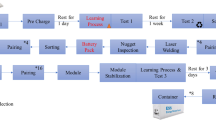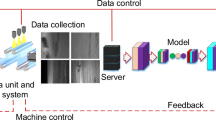Abstract
As the main component of the new energy battery, the safety vent usually is welded on the battery plate, which can prevent unpredictable explosion accidents caused by the increasing internal pressure of the battery. The welding quality of safety vent directly affects the safety and stability of the battery; so, the welding-defect detection is of great significance. In this paper, we researched the welding-defect detection method based on semantic segmentation algorithm. The automatic detection method should recognize, locate, and count the area of defects. However, small differences between inter-classes, strong variations in defect size, and uncertain annotation create challenges for defect semantic segmentation. To address these challenges, a customized deep learning model based on two-branch architecture is proposed to segment welding-defect at the pixel level. This architecture involves three modules as follows, (i) The Spatial Branch is elaborately designed to capture spatial details and generate high-resolution feature representation; (ii) The Context Branch is responsible for obtaining semantic context; (iii) The Feature Fusion Block is proposed to merge the two types of feature representation and enhance mutual connections. Furthermore, a welding image dataset was built to validate our method, and the network’s performance of defect segmentation and classification were evaluated by the defects images and the normal images, respectively. Data augmentation strategies are performed to overcome the problem of imbalanced distribution and inaccurate labels of the dataset, which is caused by the ambiguity of defect edges and the subjectivity of manual annotation. The experiment results indicate that our method achieves 86.704\(\%\) of mIoU (mean intersection of union), which supports the effectiveness of the deep learning model in segmenting defects. Besides, 98.896\(\%\) of AP (average precision) and 0\(\%\) of MDR (miss detection rate) further suggests the applicability of the proposed framework in industrial applications.







Similar content being viewed by others
References
Ren G, Meng Y, Shao B, Liu T (2016) Analysis in secondary use of new energy automotive battery. Adv Energy Power Eng 4:82–87
Cao X, Wallace W, Poon C, Immarigeon J-P (2003) Research and progress in laser welding of wrought aluminum alloys. i. laser welding processes. Mater Manuf Process 18(1):1–22
Jiang B, Wang C, Hsu Y (2007) Machine vision and background remover-based approach for pcb solder joints inspection. Int J Prod Res 45(2):451–464
Chen B, Fang Z, Xia Y, Zhang L, Huang Y, Wang L (2018) Accurate defect detection via sparsity reconstruction for weld radiographs. NDT E Int 94:62–69
Rossa R, Borella A, Giani N (2020) Comparison of machine learning models for the detection of partial defects in spent nuclear fuel. Ann Nuclear Energy 147:107680
Li B, Pi D (2020) Network representation learning: a systematic literature review. Neural Comput Appl 32(21):16647–16679
Zeiler MD, Fergus R (2014) Visualizing and understanding convolutional networks. In: European conference on computer vision, pp 818–833. Springer
Park J-K, Kwon B-K, Park J-H, Kang D-J (2016) Machine learning-based imaging system for surface defect inspection. Int J Precis Eng Manuf Green Technol 3(3):303–310
Cha Y-J, Choi W, Büyüköztürk O (2017) Deep learning-based crack damage detection using convolutional neural networks. Comput Aided Civil Infrastruct Eng 32(5):361–378
Yuan H, Chen H, Liu S, Lin J, Luo X (2019) A deep convolutional neural network for detection of rail surface defect. In: 2019 IEEE vehicle power and propulsion conference (VPPC), pp 1–4. IEEE
Chen J, Liu Z, Wang H, Nunez A, Han Z (2017) Automatic defect detection of fasteners on the catenary support device using deep convolutional neural network. IEEE Trans Instrument Measure 67(2):257–269
Shu Y, Huang Y, Li B (2019) Design of deep learning accelerated algorithm for online recognition of industrial products defects. Neural Comput Appl 31(9):4527–4540
He D, Xu K, Zhou P (2019) Defect detection of hot rolled steels with a new object detection framework called classification priority network. Comput Ind Eng 128:290–297
Volkau I, Mujeeb A, Wenting D, Marius E, Alexei S (2019) Detection defect in printed circuit boards using unsupervised feature extraction upon transfer learning. In: 2019 International conference on cyberworlds (CW), pp 101–108. IEEE
Ren S, He K Girshick R, Sun J (2015) Faster r-cnn: towards real-time object detection with region proposal networks. arXiv preprint arXiv:1506.01497
Ostu N (2007) A threshold selection method from gray-level histograms. IEEE Trans Syst Man Cyber 9(1):62–66
Long J, Shelhamer E, Darrell T (2015) Fully convolutional networks for semantic segmentation. In: Proceedings of the IEEE conference on computer vision and pattern recognition, pp 3431–3440
Simonyan K, Zisserman A (2014) Very deep convolutional networks for large-scale image recognition. arXiv preprint arXiv:1409.1556
Jain V, Seung HS, Turaga SC (2010) Machines that learn to segment images: a crucial technology for connectomics. Current Opin Neurobiol 20(5):653–666
Ronneberger O, Fischer P, Brox T (2015) U-net: Convolutional networks for biomedical image segmentation. In: International conference on medical image computing and computer-assisted intervention, pp 234–241. Springer
Chen L-C, Papandreou G, Kokkinos I, Murphy K, Yuille AL (2017) Deeplab: semantic image segmentation with deep convolutional nets, atrous convolution, and fully connected crfs. IEEE Trans Pattern Anal Mach Intell 40(4):834–848
Zhao H, Shi J, Qi X, Wang X, Jia J (2017) Pyramid scene parsing network. In: Proceedings of the IEEE conference on computer vision and pattern recognition, pp 2881–2890
Huang Z, Wang X, Huang L, Huang C, Wei Y, Liu W (2019) Ccnet: Criss-cross attention for semantic segmentation. In: Proceedings of the IEEE/CVF international conference on computer vision, pp 603–612
Fu J, Liu J, Tian H, Li Y, Bao Y, Fang Z, Lu H (2019) Dual attention network for scene segmentation. In: Proceedings of the IEEE/CVF conference on computer vision and pattern recognition, pp 3146–3154
Yuan Y, Huang L, Guo J, Zhang C, Chen X, Wang J (2018) Ocnet: Object context network for scene parsing. arXiv preprint arXiv:1809.00916
Badrinarayanan V, Kendall A, Cipolla R (2017) Segnet: A deep convolutional encoder-decoder architecture for image segmentation. IEEE Trans Pattern Anal Mach Intell 39(12):2481–2495
Canziani A, Paszke A, Culurciello E (2016) An analysis of deep neural network models for practical applications. arXiv preprint arXiv:1605.07678
Zhao H, Qi X, Shen X, Shi J, Jia J (2018) Icnet for real-time semantic segmentation on high-resolution images. In: Proceedings of the European conference on computer vision (ECCV), pp 405–420
Wu T, Tang S, Zhang R, Cao J, Zhang Y (2020) Cgnet: a light-weight context guided network for semantic segmentation. IEEE Trans Image Process 30:1169–1179
Yu C, Wang J, Peng C, Gao C, Yu G, Sang N (2018) Bisenet: Bilateral segmentation network for real-time semantic segmentation. In: Proceedings of the European conference on computer vision (ECCV), pp 325–341
Zhang H, Di X, Zhang Y (2020) Real-time cu-net-based welding quality inspection algorithm in battery production. IEEE Trans Ind Electron 67(12):10942–10950
Wang Y, Zhou Q, Liu J, Xiong J, Gao G, Wu X, Latecki LJ (2019) Lednet: A lightweight encoder-decoder network for real-time semantic segmentation. In: 2019 IEEE international conference on image processing (ICIP), pp 1860–1864. IEEE
Yang Y, Pan L, Ma J, Yang R, Zhu Y, Yang Y, Zhang L (2020) A high-performance deep learning algorithm for the automated optical inspection of laser welding. Appl Sci 10(3):933
Yang Y, Yang R, Pan L, Ma J, Zhu Y, Diao T, Zhang L (2020) A lightweight deep learning algorithm for inspection of laser welding defects on safety vent of power battery. Comput Ind 123:13306
Zhu Y, Yang R, He Y, Ma J, Guo H, Yang Y, Zhang L (2021) A lightweight multiscale attention semantic segmentation algorithm for detecting laser welding defects on safety vent of power battery. IEEE Access 9:39245–39254
Yu H, Yang Z, Tan L, Wang Y, Sun W, Sun M, Tang Y (2018) Methods and datasets on semantic segmentation: a review. Neurocomputing 304:82–103
Deng J, Dong W, Socher R, Li L-J, Li K, Fei-Fei L (2009) Imagenet: A large-scale hierarchical image database. In: 2009 IEEE conference on computer vision and pattern recognition, pp 248–255. IEEE
Acknowledgements
This research was partially supported by the Shenzhen Science and Technology Program under Grant JCYJ20210324093806017, and the Shenzhen-Hong Kong Joint Innovation Foundation under Grant SGDX20190919094401725.
Author information
Authors and Affiliations
Contributions
YY: Conceptualization, Methodology. YH: Data Curation, Writing—Original Draft, Software. HG: Resources.ZC: Investigation and Validation. ZC: Investigation and Validation. LZh: Supervision, Writing—Review and Editing.
Corresponding author
Ethics declarations
Conflict of interest
We declare that we have no financial and personal relationships with other people or organizations that can inappropriately influence our work. There is no professional or other personal interest of any nature or kind in any product, service or company that could be constructed as influencing the position presented in, or the review of, the manuscript entitled “Semantic Segmentation Supervised Deep-Learning Algorithm for Welding-Defect Detection of New Energy Battery”.
Additional information
Publisher's Note
Springer Nature remains neutral with regard to jurisdictional claims in published maps and institutional affiliations.
Rights and permissions
About this article
Cite this article
Yang, Y., He, Y., Guo, H. et al. Semantic segmentation supervised deep-learning algorithm for welding-defect detection of new energy batteries. Neural Comput & Applic 34, 19471–19484 (2022). https://doi.org/10.1007/s00521-022-07474-0
Received:
Accepted:
Published:
Issue Date:
DOI: https://doi.org/10.1007/s00521-022-07474-0




